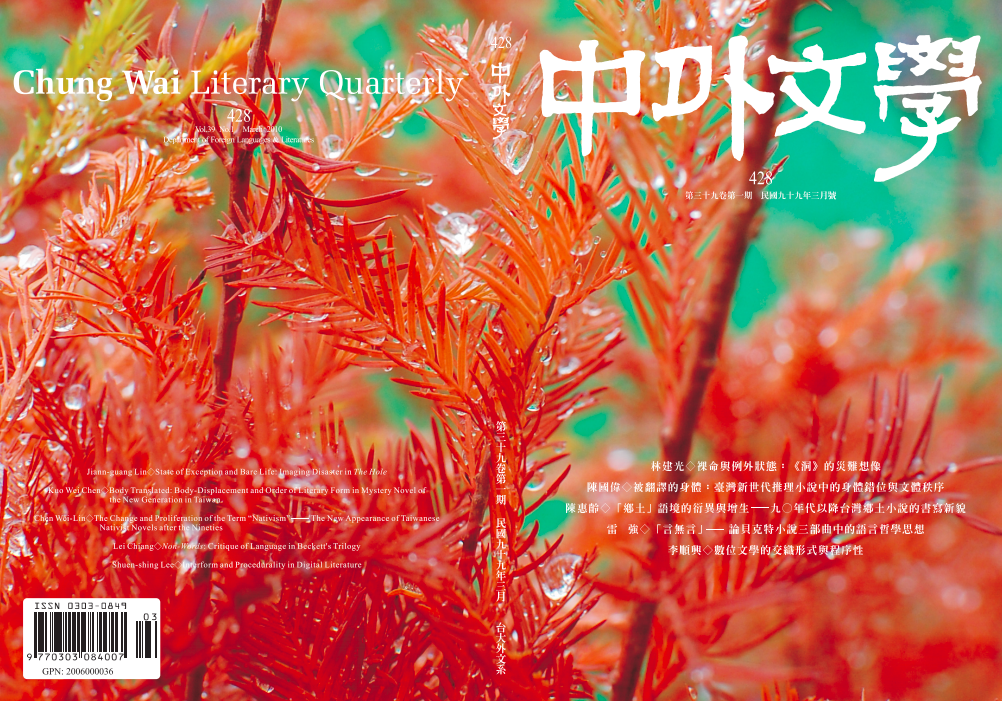第三十九卷 第一期 總428 中華民國99年3月
Vol.39 No.1 March 2010

《中外文學》三月號收錄五篇精彩論文:林建光嘗試從災難的角度重新閱讀蔡明亮的電影《洞》,並以阿岡本(Giorgio Agamben)的「裸命」(bare life)與「例外狀態」(state of exception)概念來進行詮釋;陳國偉深入探究臺灣新世代推理小說家冷言的作品《上帝禁區》如何挪用日本推理作家島田莊司《占星術殺人魔法》中的身體錯位形式;陳惠齡試圖探勘九0年代以降臺灣鄉土小說於承續與衍異中的書寫新貌;雷強從奧地利哲學家毛特納(Fritz Mauthner)的《語言批判》觀點切入,探討貝克特(Samuel Beckett)小說三部曲中的「語言困境」問題;李順興則針對黑爾茲(N. Katherine Hayles)的媒體交換作用(intermediation)與波爾特及古魯森(Jay David Bolter and Richard Grusin)的再媒體化(remediation)進行評論,提出形式交織(interformation)的可能性。
中外文學三月號目錄
Contents
林建光╱裸命與例外狀態:《洞》的災難想像
裸命與例外狀態
《洞》的災難想像
林建光*
摘要
◎關鍵詞:災難,例外狀態,裸命,即身性,離身性
★國立中興大學外國語文學系副教授。
Jian-guang Lin╱State of Exception and Bare Life: Imaging Disaster in The Hole
State of Exception and Bare Life
Imaging Disaster in The Hole
Jian-guang Lin*
Abstract
On August 8, 2009, Typhoon Morakot hit Taiwan, causing great damage to the island, especially the Southern Taiwan. A couple of days later, the term “August 8 flood disaster” began to be used to name this particular disaster. It reminded us of the “August 7 flood disaster” which occurred fifty years ago. In just a few days, the “August 8 flood disaster” almost becomes a historical event having the same weight as other natural or historical disasters, such as the “228 event,” “921 earthquake,” or “August 7 flood disaster.” The disaster, however, was strangely familiar to us. In Tsai Ming-liang’s 1998 film, The Hole, we found uncanny correspondences between fiction and reality, the past work and present situation. It seemed that the “real” and the “fictional” disaster cross-illuminated each other. This paper, therefore, attempts to reread The Hole in light of disaster.
◎Keywords: disaster, state of exception, bare life, embodiment, disembodiment
★Associate Professor, Department of Foreign Languages and Literatures, National Chung Hsing University.
陳國偉╱被翻譯的身體: 臺灣新世代推理小說中的身體錯位與文體秩序
被翻譯的身體
臺灣新世代推理小說中的身體錯位與文體秩序
陳國偉*
摘要
◎關鍵詞:推理小說,身體,文體,文化翻譯,現代性,島田莊司
★國立中興大學臺灣文學研究所助理教授。
Kuo Wei Chen╱Body Translated: Body-Displacement and Order of Literary Form in Mystery Novel of the New Generation in Taiwan
Body Translated
Body-Displacement and Order of Literary Form in Mystery Novel of the New Generation in Taiwan
Kuo Wei Chen*
Abstract
At the same time, I explore the novel as a type of popular literature, which stands for and borrows the original form from Japan, adopting the approach of cultural translation in the process of its localization. And, through the process, I investigate how it could satisfy the need of the literary order of mystery novels by narrating practice of body-order. I further inquire into how the agency of a translator could makes use of body form without regard of metaphors of nation and history, and how this process continues the classical aesthetic genre and meaning of modernity. Furthermore, the writing intention of Leng-yen might cause the inner conflict and fundamental crisis of the “order of literary form,” which is exactly what he has tried to preserve.
◎Keywords: mystery novels, physical body, literary form, cultural translation, modernity, Souji Shimada
★ Assistant Professor, Graduate Institute of Taiwan Literature, National Chung Hsing University.
陳惠齡╱「鄉土」語境的衍異與增生 ──九0年代以降台灣鄉土小說的書寫新貌
「鄉土」語境的衍異與增生
──九0年代以降台灣鄉土小說的書寫新貌
陳惠齡*
摘要
◎關鍵詞:鄉土,鄉土小說,空間,地方,九○年代,台灣文學
★國立新竹教育大學中國語文系助理教授。
Chen Wei-Lin╱The Change and Proliferation of the Term “Nativism” —The New Appearance of Taiwanese Nativist Novels after the Nineties
The Change and Proliferation of the Term “Nativism”
—The New Appearance of Taiwanese Nativist Novels after the Nineties
Chen Wei-Lin*
Abstract
◎Keywords: Nativism, Nativist Novel, 90s, Taiwanese Literature
★Assistant Professor, Department of Chinese Language and Literature Studies, National Hsinchu University of Education.
雷翔╱「言無言」 ──論貝克特小說三部曲中的語言哲學思想
「言無言」 ──論貝克特小說三部曲中的語言哲學思想
雷翔*
摘要
◎關鍵詞:貝克特,毛特納,語言批判,隱喻,沉默
★南京大學文學院比較文學與世界文學專業碩士研究生候選人。
Lei Chiang╱Non-Words: Critique of Language in Beckett’s Trilogy
Non-Words: Critique of Language in Beckett’s Trilogy
Lei Chiang*
Abstract
◎Keywords: Beckett,Mauthner, critique of language, metaphor, silence
★Master Candidate in Comparative Literature and World Literature, Nanjing University.
李順興╱數位文學的交織形式與程序性
數位文學的交織形式與程序性
李順興*
摘要
◎關鍵詞:數位文學,媒體交互作用,再媒體化,形式交織,交織形式,模擬,程序性
★國立中興大學外國語文學系教授。
Shuen-shing Lee╱Interform and Procedurality in Digital Literature
Interform and Procedurality in Digital Literature
Shuen-shing Lee*
Abstract
◎Keywords: digital literature, intermediation, remediation, interformation, interform, simulation, procedurality
★Professor, Department of Foreign Languages and Literatures, National Chung Hsing University.
